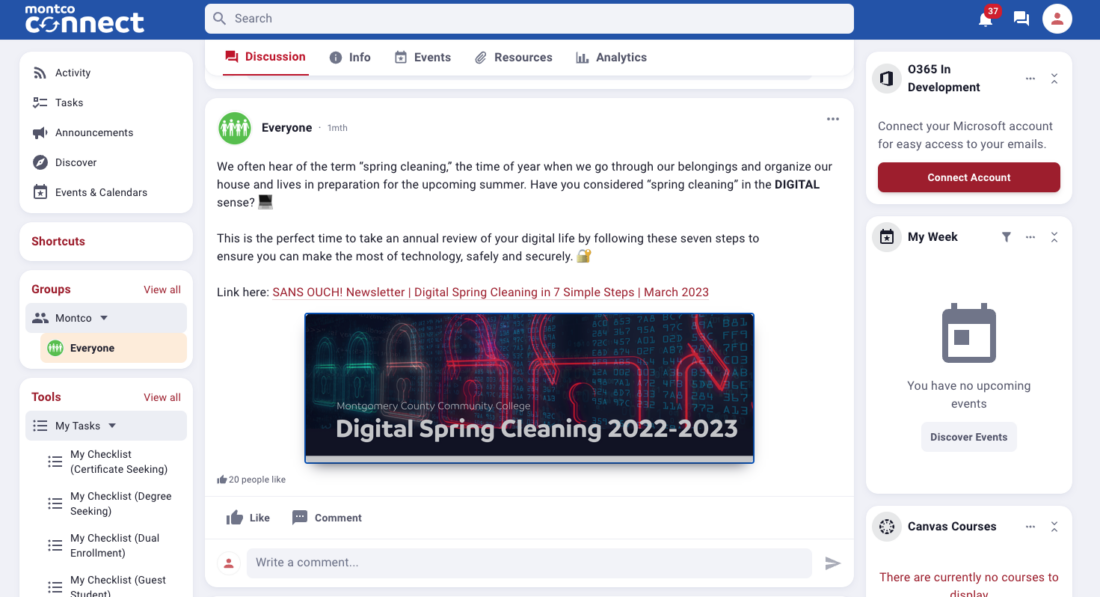
The Art of Possible: Beyond a Student Portal
Montgomery County
Community College
A Vision Within Reach
When Montgomery County Community College (Montco) began working with Pathify, it wanted a platform to proactively serve support prompts to everyone at the college.
Montco originally used Sharepoint as its student portal. However, it required a significant amount of development in order for it to function the way Joe Mancini, Executive Director of Information Technology, intended it to work to best serve students. In addition to the portal living separately from student club information, Mancini wanted a mobile app which allowed push notifications and other functions to improve the student experience.
Montco performed a rigorous search looking for a solution with strong integrations and capable of reading course information off its LMS. Montco originally considered enlisting the help of a small development shop to build a mobile app until it encountered Pathify.

About Montgomery County Community College
Montco is an institution that offers high-quality, affordable and accessible education leading to relevant, rewarding transfer and career opportunities. Students successfully transfer to numerous colleges and universities throughout the region and across the country, and two-thirds of all graduates are employed in their fields of study.
Montco offers more than 100 associate degree and certificate programs with plenty of career training and continuing education programs for learners of all backgrounds. Montco offers a variety of clubs and organizations for students to grow existing and new interests.
Implementing the Student Perspective
Mancini wanted a platform with web and mobile parity. Instead of needing a separate app or mobile experience, he believed students should have the same experience regardless of where they access their student portal.
Like many other two-year colleges, the IT Department at Montco has limited time and financial resources. Therefore, maximizing efficiency both from a human capital and technological perspective are imperative to giving students the best possible experience.
Despite limited resources, Mancini always keeps his eyes open for the newest innovations when they’re capable of benefiting the student population. Encountering Pathify turned into an opportunity for Mancini to help the IT Department do more with less while simplifying the student experience at Montco.
He first learned about Pathify at EDUCAUSE where Mancini typically discovers the latest and greatest technology available for his institution. Mancini immediately gravitated towards Pathify’s web and mobile parity capabilities and took the idea back to a student focus group for feedback.
This group saw the value Pathify offered and encouraged Montco to move forward, paving the way for a net-positive change on Montco’s campuses.
Yet, as many community colleges might recognize, change is easier said than done. Even when new technology makes a positive impact, it requires a change in culture.
“A cultural shift, regardless of the situation, is really a challenge,” Mancini said. “Almost perhaps more challenging than implementing the technology itself.”
Montco kept the student experience in perspective at each step along the way. The institution mostly used the focus group to understand how students preferred to communicate today.
“We primarily leverage [student focus groups] for technical insight, communication preferences, and things of that nature,” Mancini said. “During our implementation of Pathify, their input and feedback helped to guide the process to make it the most effective for students.”

Another positive aspect that arose during the testing phase was the ability to communicate through Pathify via the Communities module, allowing students to connect with other students.
“Being a community college is different from a university where students reside on campus,” Angela Cavaliere, Assistant Director of Digital Experience at Montco said. “Most of our students are coming and going, so they often may miss that sense of community.”
Making the Most of Pathify Communication Tools
When it was time to go live with Pathify, Montco wanted to guarantee they met students where they are. As a result, Montco implemented a number of ways to ensure students received the necessary resources in a format they would most likely use.
Montco connects with students through multiple channels such as FAQ pages, push notifications, and email outreach. This makes the college more accessible and helps to prevent students from falling through the cracks.
One way Montco helps students stay on track is through the Success module. Success helps students stay on top of various tasks by sending automated reminders related to what they must complete. It keeps important messages in front of students and helps administrators understand where students are on their onboarding journeys.
The Success module pulls tasks out of various systems such as a Student Information System to help the two-year college get the most of its investments. Drawing from the various systems within Pathify not only helps Montco to ensure students see reminders of incomplete tasks, but it also greatly simplifies the process.
Students no longer log into different systems to accomplish everything they need to enroll. Instead, everything they want is viewed through a single pane of glass in Pathify.
“Students don’t need to learn about how to navigate their menu and web interface,” Mancini said. “Once you’re [in the portal], you just add the class, pay your bill, whatever it might be. We’re really making a concerted effort to make Pathify the one place to navigate to your tasks, to communicate, etc. We’re really trying to simplify it.”
Creating Campus Culture
Students don’t feel like just a number at Montco. The college provides holistic support services to help students academically and personally. Students have high expectations on the level of support they receive from the institution.
“At Montgomery we have a culture where we want to provide services students need to be successful,” Mancini said. “But what I mean by that is oftentimes, we find products designed for other types of organizations in mind and they don’t exactly meet what we need it to do to support the students.”
When Mancini’s team examined Pathify, it wasn’t enough just to have a singular view into its various applications. He also sought a platform capable of keeping students in Pathify to connect with clubs and peers.
Montco’s interest in bringing community forward is a big reason why the institution invested funds from a 2020 NASPA Award into Communities, which students use to crowd-source answers on a variety of topics. Although students initially use Pathify because it provides a strong functional role to the college, the community aspect is why students stay in the Engagement Hub.
“I call Pathify the ‘fridge door’ in our community. If a note is left on a fridge door, it’s apt to be seen because someone’s going there for another purpose. You can’t get to the learning management system or anything else at Montco without first logging into the portal, and you’re hopefully already engaging with content there that you’re interested in. At Montco, we have over 120 student clubs or groups on the platform. Then hopefully, you see these communications about a resource that we have.”
– Joe Mancini, Executive Director, IT
Creating a caring culture means giving students the resources they need to succeed at an institution. Montco’s partnership with Pathify not only allowed the college to enhance the learning experience by conveniently providing the services they need on a user friendly platform. Today, Montco is a strategic partner in piloting many of the successful products and features Pathify offers — and a large reason is because of Mancini and his team’s help making the Engagement Hub a true one-stop for institutions all over the country.